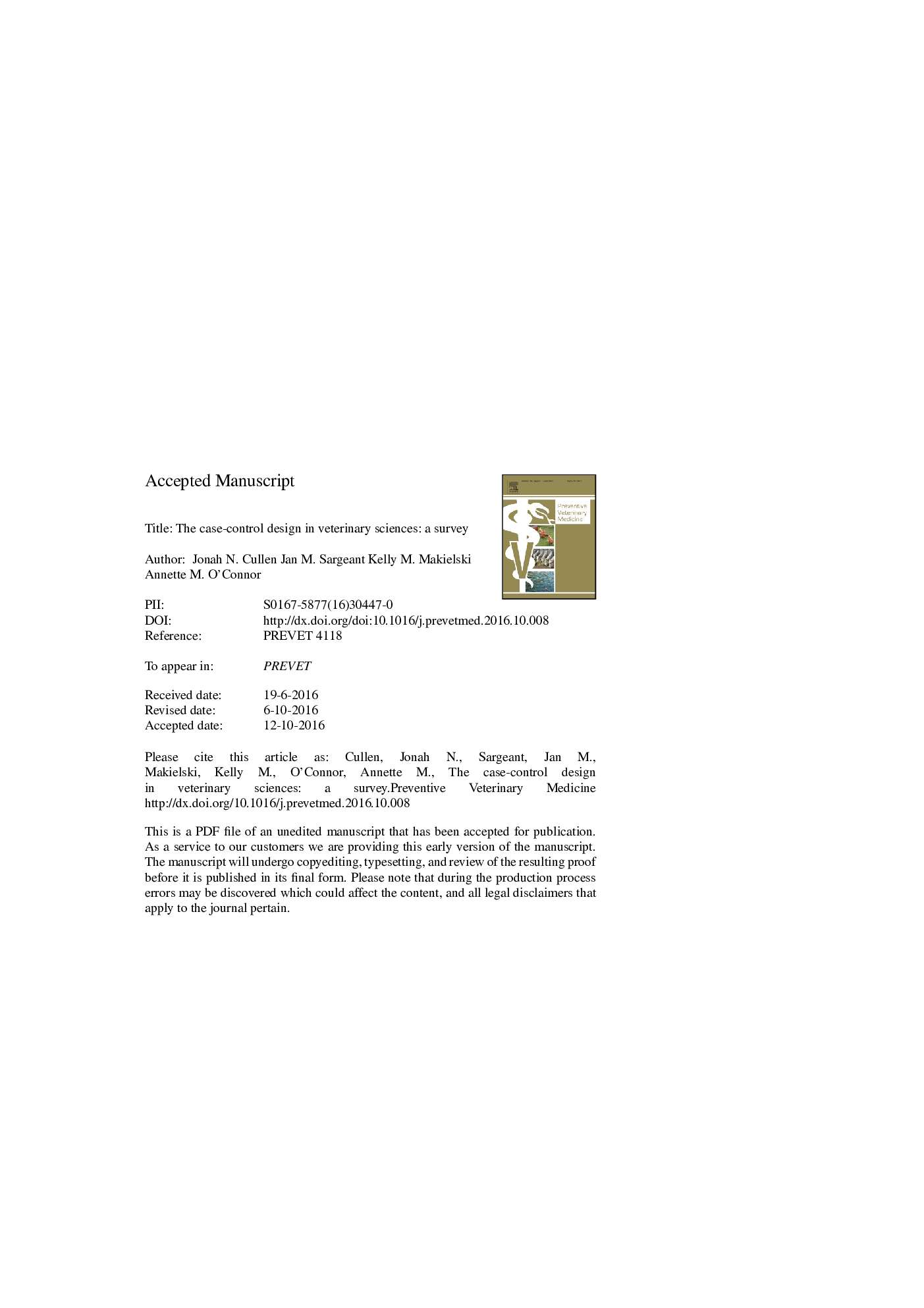| کد مقاله | کد نشریه | سال انتشار | مقاله انگلیسی | نسخه تمام متن |
|---|---|---|---|---|
| 5543630 | 1554154 | 2016 | 35 صفحه PDF | دانلود رایگان |
عنوان انگلیسی مقاله ISI
The case-control design in veterinary sciences: A survey
ترجمه فارسی عنوان
طراحی پرونده کنترل در علوم دامپزشکی: یک نظرسنجی
دانلود مقاله + سفارش ترجمه
دانلود مقاله ISI انگلیسی
رایگان برای ایرانیان
ترجمه چکیده
طراحی مطالعه موردی کنترل فریب آمیزی ساده است. با این حال، بسیاری از ملاحظات طراحی بر اندازه گیری تاثیر تخمین تاثیر می گذارد. تحقیقات در مورد مطالعات موردی در ادبیات سلامت انسان نشان می دهد که برخی از این ملاحظات در گزارش های مطالعات مورد-شاهد، توصیف نشده است. فرض ما این بود که اکثر مطالعات دامپزشکی که به عنوان کنترل مورد استفاده قرار می گیرند، طرح های چگالی حادثه هستند و بسیاری از آنها نمی توانند اندازه گیری اثر حاصل از این مطالعات را به عنوان نسبت سرعت به جای نسبت شانس تفسیر کنند. پایگاههای داده مرجع برای مطالعات موردی کنترل شده توسط نویسنده مورد جستجو قرار گرفتند. برای بررسی گزینه های مختلف طراحی طراحی شده و اندازه گیری تأثیرات برآورد شده، از 100 مطالعه به صورت تصادفی انتخاب شده انجام شد. از 100 تحقیق در مورد کنترل موردی، 83 بررسی ارتباط قرار گرفتن و نتیجه گیری، و تنها 54 (1 65.1٪) نمونه جمعیت مطالعه بر اساس یک نتیجه و به این ترتیب خواهد شد طرح کنترل مورد نظر است. دوازده مطالعه، طرحهای چگالی شایع را داشتند، اما هیچ کدام از این اصطلاحات استفاده نکردند. از مطالعاتی که نسبت شانس را به عنوان اندازه گیری اثر گزارش کردند، هیچ کدام از ملاحظات اضافی که امکان نتیجه قابل تفسیر را فراهم آورده بودند گزارش نشد. این تحقیق نشان داد که بسیاری از مطالعات برچسب دار با استفاده از کنترل مورد شاهد نبود و در میان مطالعات موردی کنترل، جنبه های طراحی کلیدی اغلب توصیف نشده بودند. فقدان اطلاعات در مورد عناصر طراحی مطالعه و فرضیه های اساسی در مطالعات موردی کنترل توانایی ایجاد اثرات اندازه گیری شده توسط مطالعه را محدود می کند و ارزش شواهدی از مطالعه ممکن است دست کم گرفته شود.
موضوعات مرتبط
علوم زیستی و بیوفناوری
علوم کشاورزی و بیولوژیک
علوم دامی و جانورشناسی
چکیده انگلیسی
The case-control study design is deceptively simple. However, many design considerations influence the estimated effect measure. An investigation of case-control studies in the human health literature suggested that some of these considerations are not described in reports of case-control studies. Our hypothesis was that the majority of veterinary studies labeled as case-controls would be incident density designs, and many would not interpret the effect measure obtained from those studies as the rate ratio rather than the odds ratio. Reference databases were searched for author-designated case-control studies. A survey of 100 randomly selected studies was conducted to examine the different design options described and estimated effect measures. Of the 100 author-identified case-control studies, 83 assessed an exposure-outcome association and, of those, only 54 (65.1%) sampled the study population based on an outcome and would thus be considered case-control designs. Twelve studies were incidence density designs but none used this terminology. Of the studies that reported an odds ratio as the effect measure, none reported on additional considerations that would have enabled a more interpretable result. This survey indicated many case-control-labeled studies were not case-control designs and among case-control studies, key design aspects were not often described. The absence of information about study design elements and underlying assumptions in case-control studies limits the ability to establish the effect measured by the study and the evidentiary value of the study might be underestimated.
ناشر
Database: Elsevier - ScienceDirect (ساینس دایرکت)
Journal: Preventive Veterinary Medicine - Volume 134, 1 November 2016, Pages 179-187
Journal: Preventive Veterinary Medicine - Volume 134, 1 November 2016, Pages 179-187
نویسندگان
Jonah N. Cullen, Jan M. Sargeant, Kelly M. Makielski, Annette M. O'Connor,
